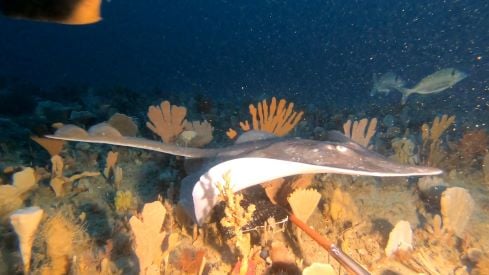Underwater drones reveal rich biodiversity in Apollo Marine Park
Media release
Deakin University's Marine Mapping Group have used underwater drones and baited cameras to reveal the incredible biodiversity of Apollo Marine Park.
The research highlights the diverse ecosystems, rich biodiversity and vulnerable species within the park, located in the waters south of Cape Otway on the Great Ocean Road.
The program is funded by the Our Marine Parks Grant Program by Parks Australia through the Australian Government.
Research Fellow Dr Mary Young said that insights from the research will help inform the management of Australia’s temperate marine ecosystems.
'Apollo Marine Park's seafloor hosts a range of valuable ecosystems, from slow growing sponge gardens to sparse, sandy sediment.
Research footage from our underwater drones shows that the Park’s shallower, rocky reef areas support complex sponge gardens which are clusters of simple invertebrate animals,' said Dr Young.
'Like coral reefs found in warmer waters, the sponge gardens of Australia's cooler waters provide essential habitat and foraging grounds for marine species. They are a key ecosystem type across the Great Southern Reef.'
In Apollo Marine Park's deeper water, strong west to east currents create vast sand-swept seascapes.
'Although this habitat may look sparse, our research reveals that it supports large schools of fish like snapper and barracouta,' said Dr Young.
The underwater footage also captured species of significant conservation concern such as the Teleost Blue Warehou (Seriolella brama), which is listed as Conservation Dependent under the EPBC Act, the Melbourne Skate (Spiniraja whitleyi), Mako shark (Isurus oxyrinchus), and Broadnose Sevengill shark (Notorynchus cepedianus), all listed as Vulnerable by the International Union for Conservation of Nature, and the School shark (Galeorhinus galeus).
As well as mapping the natural values of Apollo Marine Park, the research team investigated marine life amongst the wreck of the SS City of Rayville – a casualty of World War Two sunk by a sea mine in 1940.
Associate Professor of Marine Science Dr Dan Ierodiaconou imaged the wreck using sonar and video equipment in 2009 and returned in 2023 to collect data on the biodiversity around the structure.
The wreck acts as an artificial reef supporting a high biomass and diversity of fishes including cods, Bight redfish and snapper.
'Our research not only reveals the Apollo Marine Park's diverse ecosystems and biodiversity but connects to its historical significance, making it a place of both ecological and cultural value,' said Dr Ierodiaconou.
In this exciting project, the Deakin Marine Mapping team plan to support the Eastern Maar's new Sea Country Guardians to build capacity to conduct their own biodiversity surveys on Sea Country. Alongside this work the Eastern Maar hope to develop a Cultural Values map of Apollo and surrounding Sea Country.
https://drive.google.com/drive/folders/1yYFC-Y3XBy70SAYAF3e4eevqa2knH3D_?usp=sharing

